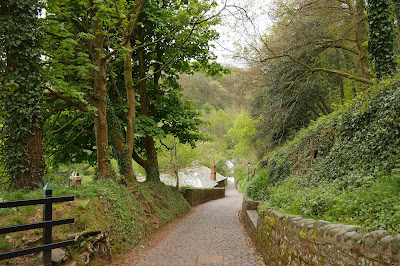Beach at Westward Ho!
A dismal day for our walk from Westward Ho! to Appledore: grey, cool and raining. Just for once I left my camera behind and relied on my iPhone, although the picture above is one I took yesterday evening. It shows the massive sandy area which stretches (at least at low water) from Westward Ho! across the estuary of the Taw and Torridge rivers to Saunton Sands. The Saunton Sands hotel is the white building on the left in the photo.
We walked along the sea front and past some seaside shops including one selling Foot Ball's. We walked up behind the beach, but a bit disappointed that we could nothing of it because of the steep ridge of pebbles. There were some hardy surfers out and it would have been diverting to watch their efforts. The ridge looked man-made, but we later saw an interesting information panel which explained that it was the result of longshore drift. The pebbles start life in the cliffs around Hartland Point and are knocked off by the action of waves and are polished on their way down the coast.
After a while we skirted the golf course, enjoying the helpful warning signs BEWARE GOLF. This was the view looking back to the town.
We were now near the small protected area of dunes and could again see the open sea across to Baggy Point.
Shortly, we reached the wide estuary mouth. With suitable magnification, the other side of the estuary can be made out just in front of the white hotel building.
The path now curves round until you are walking along the other side of this projecting area of low-lying salt marsh. This was the view across to the north end of Appledore. It is a bit confusing because the are to the right is not part of the Torridge but a a sort of bay off the estuary, marked as Skern on the OS map.
Here is a more representative view of Appledore taken across the Torridge from Instow on a previous trip.
We followed the edge of Skern and crossed Appledore Bridge to reach a road, Long Lane, which in turn led to a pth which took us into Appledore. We entered the town through a lovely street of cheerfully painted characterful houses. It was of course now too wet for even a iPhone photo.
Conditions: cloudy, cool, wet.
Distance: 5 miles.
Rating: Easy.
Map: Explorer 126 (Clovelly & Hartland).
Rating: two stars. One of those stretches you wouldn't do unless you were trying to complete the entire coast path.






















































